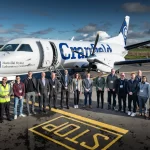The ICON project (‘Innovative cloud cooperative navigation’), led by GMV, has developed a concept demonstrator, enabled by high-speed, low-latency wireless communication networks and cloud-based data/signal processing.
“We wanted to exploit different positioning technologies and sensors, enabled by wireless communications and based on the cloud processing of the data and signals from multiple sources and peer users,” said GMV Section Head PNT-UK Division Enrique Aguado, speaking at the ICON final presentation.
The GMV team used commercial off-the-shelf (COTS) hardware, wireless communications platforms and services, avoiding the use of special-made infrastructure and location-specific information, e.g. maps of buildings. Different use cases were assessed, including internet of things (IoT) and location-based services (LBS) scenarios.
The core of the ICON project was a sophisticated ‘Cloud Cooperative Processing Module’ (CCPM) Which integrated various data inputs and positioning algorithms, including snapshot GNSS processing, signals of opportunity (SoOp) fingerprinting, pedestrian dead reckoning (PDR), and peer-to-peer ranging, along with sensor fusion for comprehensive PVT solutions.
Gaining ground
Cloud platforms offering on-demand data storage and processing capabilities are becoming more and more common. The cloud processing of GNSS signal snapshots has also emerged as a promising approach, offering potential benefits in power consumption and computational efficiency by offloading processing tasks from local devices.
“The ICON cloud-based CCPM is an advanced and sophisticated development, showing robust performance over extended validation,” said Aguado. “We can say that cloud computing implementation is already a template and reference for other GMV developments.”
ICON introduced key technologies, such as PDR positioning, peer-to-peer positioning and new sensor fusion processes. All of these were assessed under a variety of test scenarios, including indoor navigation at the University of Nottingham. “The system performed well, within the constraints of the environments and measurement quality employed,” said Aguado. “We looked at a lot of different solutions, some of which we are planning to use in subsequent projects, and others that remain for future opportunities.
“Looking forward, a snapshot GNSS receiver could be further developed to process the new generation GNSS signal, offering gains in low power operation and higher sensitivity at lower energy cost.” As interest in the IoT and smart cities continues to grow, the exploration of other emerging wireless technologies and the additional refinement of the the ICON project’s CCPM sensor fusion algorithms to improve accuracy and reliability across diverse environments could also prove fruitful, Aguado said.
ICON is yet another successful research initiative funded by the European Space Agency’s NAVISP program.

![ICON testing at the Nottingham Geospatial Building; Image courtesy ESA[88]](https://insidegnss.com/wp-content/uploads/2024/07/ICON-testing-at-the-Nottingham-Geospatial-Building-Image-courtesy-ESA88.jpg)


